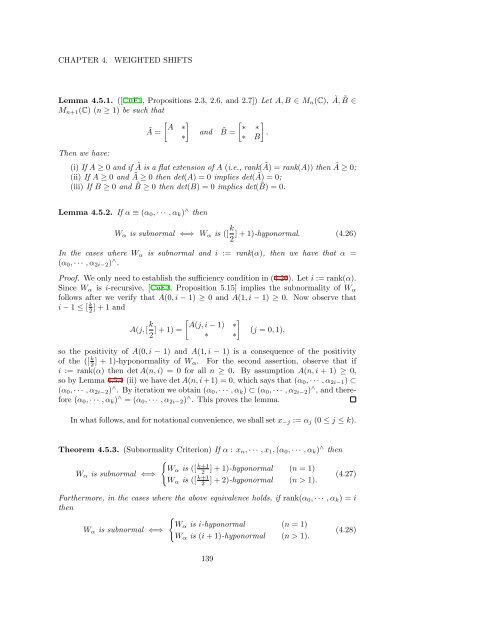Woo Young Lee Lecture Notes on Operator Theory
Woo Young Lee Lecture Notes on Operator Theory
Woo Young Lee Lecture Notes on Operator Theory
Create successful ePaper yourself
Turn your PDF publications into a flip-book with our unique Google optimized e-Paper software.
CHAPTER 4.<br />
WEIGHTED SHIFTS<br />
Lemma 4.5.1. ([CuF2, Propositi<strong>on</strong>s 2.3, 2.6, and 2.7]) Let A, B ∈ M n (C), Ã, ˜B ∈<br />
M n+1 (C) (n ≥ 1) be such that<br />
[ [ ]<br />
A ∗ ∗ ∗<br />
à = and ˜B = .<br />
∗]<br />
∗ B<br />
Then we have:<br />
(i) If A ≥ 0 and if à is a flat extensi<strong>on</strong> of A (i.e., rank(Ã) = rank(A)) then à ≥ 0;<br />
(ii) If A ≥ 0 and à ≥ 0 then det(A) = 0 implies det(Ã) = 0;<br />
(iii) If B ≥ 0 and ˜B ≥ 0 then det(B) = 0 implies det( ˜B) = 0.<br />
Lemma 4.5.2. If α ≡ (α 0 , · · · , α k ) ∧ then<br />
W α is subnormal ⇐⇒ W α is ([ k ] + 1)-hyp<strong>on</strong>ormal. (4.26)<br />
2<br />
In the cases where W α is subnormal and i := rank(α), then we have that α =<br />
(α 0 , · · · , α 2i−2 ) ∧ .<br />
Proof. We <strong>on</strong>ly need to establish the sufficiency c<strong>on</strong>diti<strong>on</strong> in (4.26). Let i := rank(α).<br />
Since W α is i-recursive, [CuF3, Propositi<strong>on</strong> 5.15] implies the subnormality of W α<br />
follows after we verify that A(0, i − 1) ≥ 0 and A(1, i − 1) ≥ 0. Now observe that<br />
i − 1 ≤ [ k 2 ] + 1 and A(j, [ k [ A(j, i − 1)<br />
2 ] + 1) = ∗<br />
] ∗<br />
∗<br />
(j = 0, 1),<br />
so the positivity of A(0, i − 1) and A(1, i − 1) is a c<strong>on</strong>sequence of the positivity<br />
of the ([ k 2 ] + 1)-hyp<strong>on</strong>ormality of W α. For the sec<strong>on</strong>d asserti<strong>on</strong>, observe that if<br />
i := rank(α) then det A(n, i) = 0 for all n ≥ 0. By assumpti<strong>on</strong> A(n, i + 1) ≥ 0,<br />
so by Lemma 4.5.1 (ii) we have det A(n, i + 1) = 0, which says that (α 0 , · · · , α 2i−1 ) ⊂<br />
(α 0 , · · · , α 2i−2 ) ∧ . By iterati<strong>on</strong> we obtain (α 0 , · · · , α k ) ⊂ (α 0 , · · · , α 2i−2 ) ∧ , and therefore<br />
(α 0 , · · · , α k ) ∧ = (α 0 , · · · , α 2i−2 ) ∧ . This proves the lemma.<br />
In what follows, and for notati<strong>on</strong>al c<strong>on</strong>venience, we shall set x −j := α j (0 ≤ j ≤ k).<br />
Theorem 4.5.3. (Subnormality Criteri<strong>on</strong>) If α : x n , · · · , x 1 , (α 0 , · · · , α k ) ∧ then<br />
{<br />
W α is ([ k+1<br />
W α is subnormal ⇐⇒<br />
2<br />
] + 1)-hyp<strong>on</strong>ormal (n = 1)<br />
W α is ([ k+1<br />
2 ] + 2)-hyp<strong>on</strong>ormal (n > 1). (4.27)<br />
Furthermore, in the cases where the above equivalence holds, if rank(α 0 , · · · , α k ) = i<br />
then<br />
{<br />
W α is i-hyp<strong>on</strong>ormal (n = 1)<br />
W α is subnormal ⇐⇒<br />
(4.28)<br />
W α is (i + 1)-hyp<strong>on</strong>ormal (n > 1).<br />
139













